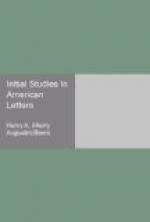was thirty-eight when he took his place among the
Concord literati. His childhood and youth had
been spent partly at his birthplace, the old and already
somewhat decayed sea-port town of Salem, and partly
at his grandfather’s farm on Sebago Lake, in
Maine, then on the edge of the primitive forest.
Maine did not become a State, indeed, until 1820,
the year before Hawthorne entered Bowdoin College,
whence he was graduated in 1825, in the same class
with Henry W. Longfellow and one year behind Franklin
Pierce, afterward President of the United States.
After leaving college Hawthorne buried himself for
years in the seclusion of his home at Salem.
His mother, who was early widowed, had withdrawn
entirely from the world. For months at a time
Hawthorne kept his room, seeing no other society than
that of his mother and sisters, reading all sorts
of books and writing wild tales, most of which he
destroyed as soon as he had written them. At
twilight he would emerge from the house for a solitary
ramble through the streets of the town or along the
sea-side. Old Salem had much that was picturesque
in its associations. It had been the scene of
the witch trials in the seventeenth century, and it
abounded in ancient mansions, the homes of retired
whalers and India merchants. Hawthorne’s
father had been a ship captain, and many of his ancestors
had followed the sea. One of his forefathers,
moreover, had been a certain Judge Hawthorne, who in
1691 had sentenced several of the witches to death.
The thought of this affected Hawthorne’s imagination
with a pleasing horror, and he utilized it afterward
in his House of the Seven Gables. Many
of the old Salem houses, too, had their family histories,
with now and then the hint of some obscure crime or
dark misfortune which haunted posterity with its curse
till all the stock died out or fell into poverty and
evil ways, as in the Pyncheon family of Hawthorne’s
romance. In the preface to the Marble Faun
Hawthorne wrote: “No author without a trial
can conceive of the difficulty of writing a romance
about a country where there is no shadow, no antiquity,
no mystery, no picturesque and gloomy wrong, nor any
thing but a commonplace prosperity in broad and simple
daylight.” And yet it may be doubted whether
any environment could have been found more fitted to
his peculiar genius than this of his native town, or
any preparation better calculated to ripen the faculty
that was in him than these long, lonely years of waiting
and brooding thought. From time to time he contributed
a story or a sketch to some periodical, such as S.
G. Goodrich’s annual, the Token, or the
Knickerbocker Magazine. Some of these
attracted the attention of the judicious; but they
were anonymous and signed by various noms de plume,
and their author was at this time—to use
his own words—“the obscurest man of
letters in America.” In 1828 he had issued
anonymously and at his own expense a short romance,




